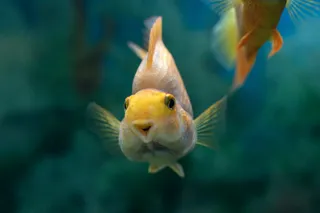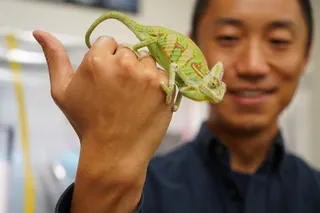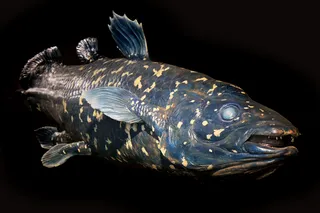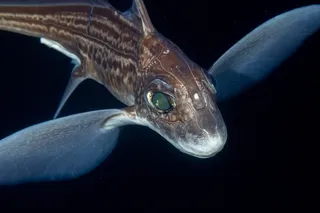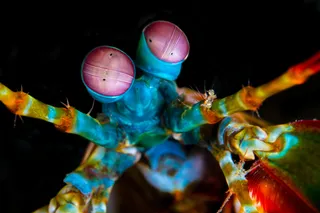Our bodies are made up of hundreds of different types of cells, but stem cells can become all of them. Over the last five years, scientists have made great advances in reprogramming specialised adult cells back into a stem-like state, turning back the clock and restoring their lost potential. These “induced pluripotent stem cells” or iPSCs could be used to create personalised treatments for diseases, or even new body parts, which are tailored to an individual’s genome. The journal Science named iPSCs as its Breakthrough of the Year in 2008. Since their discovery in 2006, research on these cells has rocketed ahead and this timeline charts the progress of this exciting field, right up to today's latest discovery. For readers who are using Readers or phones and cannot see the timeline, all of its content is available as text below. This timeline was inspired by John Rennie's manifesto on how to improve science journalism, by looking at the stories that lead up to new discoveries, rather than focusing on every new paper in isolation.
Reprogrammed stem cells on Dipity.
Aug 26, 2005 - The seeds are planted Kevin Eggan at Harvard University found that he could reprogram adult skin cells
into an embryonic state by fusing them with actual embryonic stem cells. The term iPSC hadn’t even been coined yet, but this was an important step. It showed that adult cells can regain some of their lost potential and become more ‘stem-like’. It also showed that embryonic stem cells have something inside them that can help adult cells on their way. The challenge was to find these elusive chemicals... Aug 10, 2006 - The first iPSCs Shinya Yamanaka from Kyoto University fired the starting pistol
. His team was the first to successfully turn back the clock on adult cells. They transformed skin cells from the tails of adult mice into those that looked a lot like embryonic stem cells. Like true embryonic stem cells, these “induced pluripotent stem cells" (iPSCs) could divide into a wide variety of cells and tissues. The technique depended on just four genes - Oct4, Sox2, c-Myc and Klf4 – a quartet that would come to be known as Yamanaka factors. Jun 6, 2007 - iPSCs work in mouse embryos Yamanaka expanded on his earlier work
, along with two other teams led by Rudolf Jaenisch at MIT
and Konrad Hochedinger of the Harvard Stem Cell Institute
. For the first time, the three teams showed that the iPSCs could help to produce adult cells if they were injected into mouse embryos. They were even more like embryonic stem cells than Yamanaka’s earlier paper had suggested. Unfortunately, and this is a problem that will continue to rear its head for years, some of the animals went on to develop cancers. The team used viruses to insert the Yamanaka factors into the mouse genomes. If these end up in the wrong place, they could cause genetic chaos and ultimately cancer. It doesn’t help that one of the four genes – c-Myc – is involved in cancer. And so far, no one had been able to create human iPSCs. Yet... Nov 20, 2007 - Human iPSCs arrive A major milestone: two independent groups managed to create iPSCs from human cells in a photo-finish tie. Yamanaka, naturally, was one of them
. He used the same four genes from his mouse experiments to transform skin cells taken from the face of a 36-year-old woman and connective tissue from a 69-year-old man. He even managed to coax the resulting iPSCs into neurons and heart muscle cells. Meanwhile, James Thomson from the University of Wisconsin
managed to reprogram skin cells from a foetus and from the foreskin of a baby boy. And a month later, George Daley’s group from Harvard Medical School
became the third to produce human iPSCs. In the next two years, scientists would go on to create iPSCs from a variety of human tissues, including stomach, pancreatic, liver and immune cells, as well as neurons. These studies raised some important issues. Yamanaka used the same quartet of genes in his mouse experiments, but Thomson swapped out c-Myc and Klf4 for Nanog and Lin28. That was important, for c-Myc is linked to several cancers. Just ten days later, Yamanaka showed that he could produce iPSCs without Myc, using only the three other genes. Meanwhile, Yamanaka found big differences in the activity of 4% of the iPSC genes, compared to those of true embryonic stem cells. Are these cells really the same? Dec 6, 2007 - iPSCs cure sickle cell anaemia in mice From hype to reality. Rudolf Jaenisch cured mice of a genetic disorder
called sickle cell anaemia using personalised stem cells. His team took cells from the skin of the rodents’ tails, reprogrammed them, corrected their genetic defect, and injected them back into the mice. Just four weeks later, the iPSCs had begun producing normal blood cells and the mice were no longer anaemic. It was a powerful ‘proof-of-principle’ that iPSCs could one day fulfil their potential in fighting human disease. Mar 7, 2008 - One that failed Nature reported that a Californian biotech company called PrimeGen claimed to be able to create iPSCs using carbon nanotubes. The tubes would act as a vehicle for shuttling the reprogramming genes into the cells. The claims were made at a conference of investors, many scientists were skeptical, and no published peer-reviewed paper has come of it Apr 15, 2008 - Rat model of Pakinson’s Jaenisch tried to repeat his sickle cell success with Parkinson’s disease
. He coaxed iPSCs into becoming neurons and transplanted them into the brain of a rat, displaying signs of Parkinson’s disease. The new neurons integrated into the brains of their hosts and the rats’ symptoms improved. However, some of them developed tumours, highlighting again the potential risks of this technique. Jun 22, 2008 - Small molecules boost efficiency When Yamanaka tried to create iPSCs without the potential cancer-causing Myc gene, he found that the process worked but slowly and inefficiently. Douglas Melton from Harvard University found a solution
. With a suite of small molecules, such as valproic acid, he managed to boost the efficiency of the Myc-less technique by more than 100 times. Jul 15, 2008 - ALS cells reprogrammed Building on successes in mice
, Kevin Eggan from Harvard University created iPSCs from skin cells taken from an 82-year old woman with amyotrophic lateral sclerosis (ALS)
. This is the same condition that has paralysed Stephen Hawking. Even after a lifetime of chronic disease, the adult cells could still be reverted to a stem-like state. Eggan then converted the iPSCs into motor neurons, the same cells affected by the donor’s disease. The results were a boon for ALS researchers, and an example of one of the big benefits of iPSCs. Research into ALS is slow because it’s nigh impossible to obtain a decent supply of living neurons affected by the condition. This study changed all of that, and it was just the beginning... Aug 7, 2008 - Diseases ahoy Two months after Eggan’s group produced iPSCs from a patient with ALS, George Daley announced the creation of iPSCs from ten genetic disorders
. The list includes a who’s who of important inherited diseases including Huntington Diseases, Down syndrome, Duchenne muscular dystrophy, and others with a strong genetic component, such as juvenile-onset type 1 diabetes and Parkinson disease. As with the ALS iPSCs, these aren’t breakthrough in themselves. Instead, they open doors for future discoveries. Sep 25, 2008 - A safer method? Previously, scientists had created iPSCs using viruses that shove their DNA cargo into a cell’s own genome. This approach is risky. If the DNA ends up in the wrong place and disrupts the wrong gene, the result could be cancer. But this isn’t necessary. Konrad Hochedlinger from Harvard University managed to do the same thing with adenoviruses
, a group of viruses that stay out of their hosts’ DNA. There was a catch – the process was slower and less efficient. Dec 22, 2008 - SMA cells reprogrammed Clive Svendsen from the University of Wisconsin took skin cells taken from a patient with spinal muscular atrophy
(SMA) and reprogrammed them into iPSCs. Others had created many such lines from people with other diseases, but Svendsen went one step further. He showed that the reprogrammed cells kept their genetic defects and produced neurons with the same problems. And that makes them a valuable resource for studying the disease in the lab. For example, scientists can expose these cells to experimental drugs to see how they respond. Jan 12, 2009 - iPSCs treat haemophilia in mice Yupo Ma from the Nevada Cancer Institute used iPSCs to treat a genetic disease called haemophilia A in mice
. The disease is caused by a single faulty gene that stops blood from clotting properly. Ma created iPSCs using three of the Yamanaka factors (without Myc) and transplanted them into the haemophiliac mice. Normally, these animals would bleed to death within a few hours if they get a small cut in their tails. After the iPSC treatment, they could survive a cut for several months. This was the second genetic disorder to be treated with iPSCs, but it’s still only a triumph in mice. Before human trials can start, there are still many big safety issues to address. Feb 12, 2009 - iPSCs into beating heart cells Transforming cells into iPSCs is one thing; turning them back into other types of cells is quite another. Tim Kamp from the University of Wisconsin managed to turn iPSCs into various types of heart cells, which could even be seen beating in a dish
. Mar 1, 2009 - No viruses needed Scientists have reprogrammed cells with two different types of viruses. But two groups led by Andras Nagy from Mount Sinai Hospital
and Keisuke Kaji from the University of Edinburgh managed to produce iPSCs without any viruses at all. They loaded Yamanaka factors into a DNA “cassette” that could jump into the genome of a host cell. Once the cells had been transformed, the cassette could be cut back out. Apr 23, 2009 - No genes needed iPSCs can be made without using genes at all. Sheng Ding from the Scripps Research Institute
took the proteins encoded by the four Yamanaka factors and tagged them with a backstage-pass – a molecule that gave them entry into mouse cells. A month later, Kwang-Soo Kim from Harvard Medical School
managed to do the same thing using human cells. Jun 23, 2009 - iPSCs make mice In perhaps the ultimate test of the potential of iPSCs, two teams used these reprogrammed cells to produce living mice. Qi Zhou from the Chinese Academy of Sciences created a mouse called Xiao Xiao
by implanting iPSCs into a developing embryo when it was still a ball of cells. He transplanted the embryo into a surrogate mother, which gave birth to a healthy pup 20 days later. All in all, Zhou reared 27 pups from iPSCs transplants and 12 of these survived to adulthood and have produced young of their own. A second group led Shaorong Gao
of the Chinese Academy of Medical Sciences achieved the same feat. Aug 9, 2009 - Immortality helps No fewer than five separate groups
(including Yamanaka’s and Hochedlinger’s) hit on the same way of producing iPSCs more efficiently – making them immortal. All of them focused on p53, the so-called “guardian of the genome”, which prevents cells from becoming cancerous. By knocking out this guardian, or other genes that work together with it, the teams managed to turn a far greater proportion of adult cells into iPSCs. The approach has clear risks and it will never be used to create stem cells for treating patients. But it could help scientists to create more iPSCs for use in their research. Oct 11, 2009 - Separating wheat from chaff When adult cells are reprogrammed into iPSCs, not all of them make the full transition. George Daley and Thorsten Schlaeger found a set of molecules that can tell the fully-reprogrammed cells from their incomplete cousins
. They even managed to see these molecules under the microscopy by using glowing antibodies designed to find and stick to them. With these glowing signposts, they could watch the fate of their iPSCs on a live broadcast. Nov 10, 2009 - Speeding it up Right from Yamanaka’s first experiments, only a small proportion of adult cells could ever be transformed into iPSCs. Some wondered if only a small proportion of cells had the potential to regain their potential. But Rudolf Janiesch showed that it was just a matter of time. It’s a constant and random process
. Give it long enough – say 18 weeks – and almost all cells can be reprogrammed. Janiesch also found ways of speeding up the transformations, either by making the cells divide faster, or by cutting down the number of divisions it takes before they transform. Feb 11, 2010 - Stem cells not as we know them As research with iPSCs blazes ahead, some scientists start to report important problems. Sun-Chun Zhang from the University of Wisconsin
found that iPSCs produce neurons at a slower pace than true embryonic stem cells. In the same week, Robert Lanza from Stem Cell and Regenerative Medicine International
found the same thing for blood cells. Not only that, but the cells they did produce were more likely to grow slowly, age prematurely and die spontaneously. One month later, another group found one of the reasons behind these problems... Mar 31, 2010 - A genetic flaw Konrad Hochedlinger found a set of important genetic differences that separate mouse iPSCs from genuine embryonic stem cells
. On their 12th chromosome, they have a cluster of genes that is much less active. If human iPSCs have similar silenced genes, this could explain why they aren’t as good as embryonic stem cells at producing other types of cells. The true scale of these differences would become clear in a few months... Jun 21, 2010 - Forget genes, just use viruses Some scientists have found ways of producing iPSCs without any viruses, using either the Yamanaka factors or the proteins that they encode. But Andrew Baker at the University of Glasgow went the other way
. At the annual meeting of the International Society for Stem Cell Research, he announced that he could create iPSCs form human skin cells using only viruses, without any of Yamanaka factors or any other reprogramming genes. It was like saying you could use a car without a driver. Not everyone was convinced, but Baker’s results were published four months later. Jul 19, 2010 - Memories of past lives It’s not so easy to turn back the clock. Even after they’ve been reprogrammed, iPSCs carry a memory of their past
identities that constrains their future. George Daley’s group found
that iPSCs still carry molecular marks that annotate their DNA. These “epigenetic” changes mean that it is easier, for example, to produce blood cells from iPSCs that themselves came from blood cells, rather than those derived from connective tissue or brain cells. This explains a lot of earlier results, including the differences in gene activity between iPSCs and true embryonic stem cells. There are a few possible ways around these problems. You could use chemicals to try and strip away the epigenetic marks. Or, as Hochedlinger’s group found
, you could simply grow the cells for a long time. Nov 17, 2010 - iPSCs tag jumping genes By creating iPSCs from cells with genetic disorders, scientists were supposedly creating important tools for studying these diseases. Alysson Muotri and Maria Marchetto from The Salk Institute proved that point by studying a genetic disorder called Rett syndrome
. The disease stops neurons from developing properly, and the duo suspected the involvement of DNA sequences called L1s, which can jump around the genome. To test that, they took cells from girls with or without Rett syndrome and transformed them all into iPSCs
. They tagged the L1 gene so that it gave off a green glow and watched it hopped around the genome. The telltale fireflies revealed that Rett syndrome neurons have twice as much active L1 as those from the other children. Dec 12, 2010 - iPSCs into intestinal tissue iPSCs have been transformed into various types of cells, but typically in a dish. James Wells from the Cincinnati Children’s Hospital Medical Center went one step further by turning iPSCs into three-dimensional pieces of intestinal tissue.
He did it using a cocktail of growth factors, delivered at a precise schedule. His “organoids” should help scientists to study human organs in the confines of a lab. Feb 01, 2011 – Reprogramming errors, lots of them Like Daley last year, Joseph Ecker’s group from The Salk Institute found epigenetic differences between iPSCs and true embryonic stem cells,
but this time in human cells. By comparing methyl marks across the entire genomes of iPSC lines, embryonic stem cells and adult cells, Ecker found reprogramming errors that were more extensive than anyone had suspected. Many of these errors were common to all iPSC lines, and some were unique to individual ones. They could be passed on to daughter cells created form the iPSCs. The abnormal marks seemed to cluster around structures are the centre and tips of chromosomes –the centromeres and telomeres. Ecker thinks the DNA at these places might be packaged and folded in such a way that makes methyl marks harder to remove. Now, they’re testing chemicals that target or open up these areas, in the hope of producing a ‘stemmier’ breed of iPSCs. Still to come - ?


